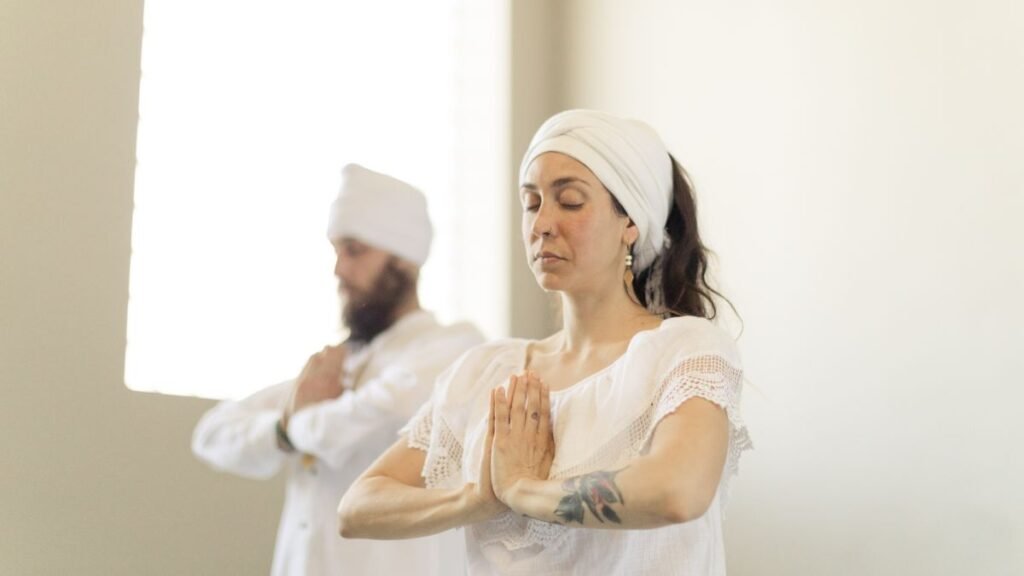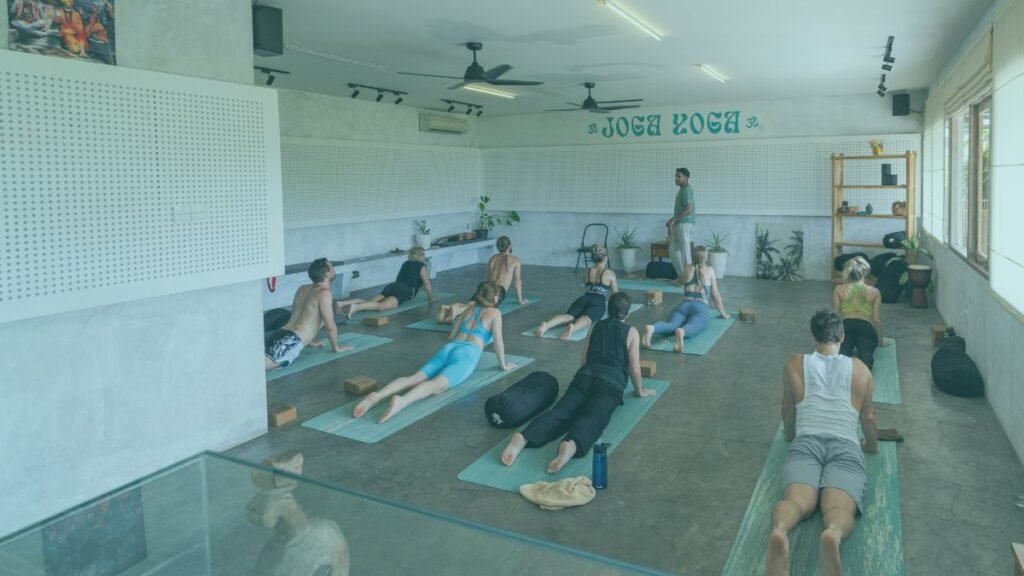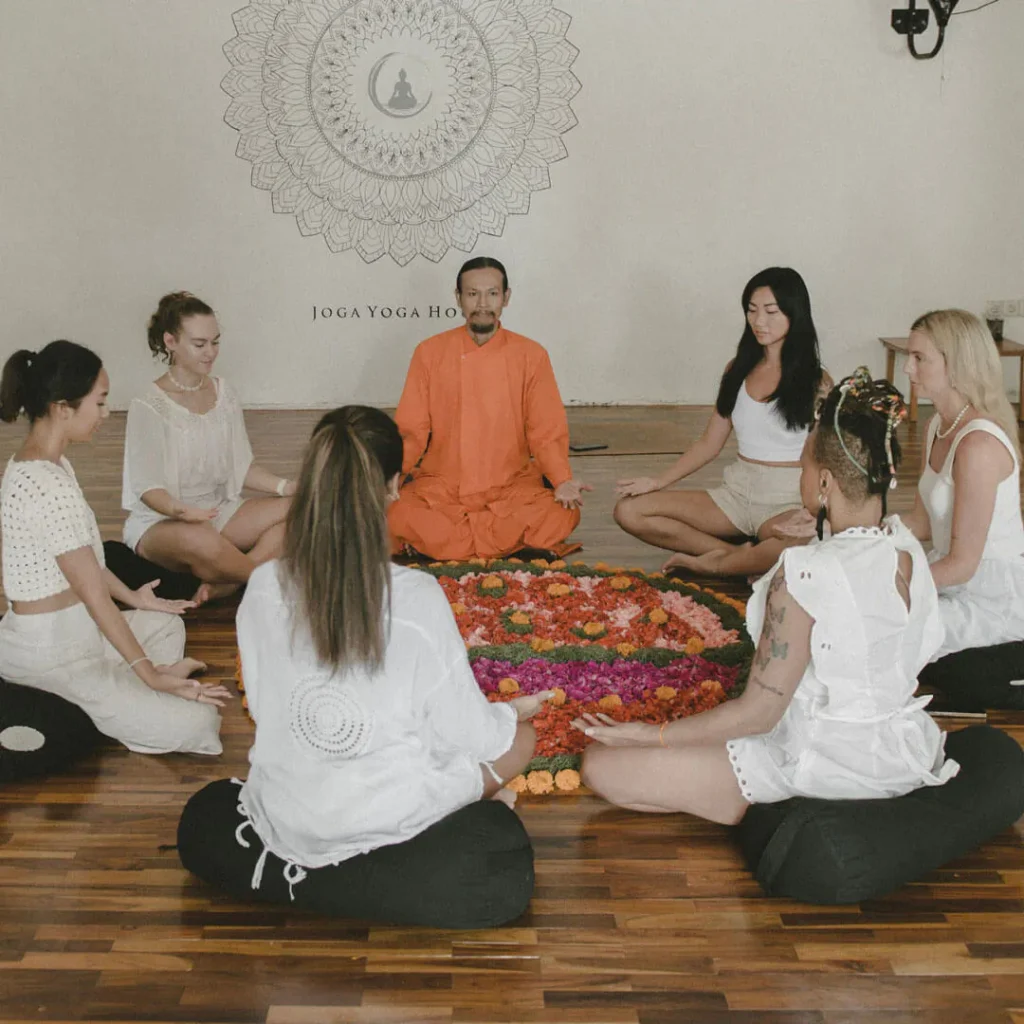Introduction
Kundalini Yoga is a powerful style of yoga that focuses on waking up the energy at the base of your spine, called Kundalini energy. Through breathing exercises, movement, chanting, and meditation, this energy is guided up through the body’s energy centers, or chakras. Many people practice Kundalini Yoga to feel more connected, clear-minded, and spiritually awake.
But some people also say Kundalini Yoga can be intense or even risky. There are stories of people feeling overwhelmed or confused after doing it, especially without proper guidance. This has led many to ask, “Is Kundalini Yoga dangerous?”
In this article, we’ll take a closer look at that question. We’ll talk about what Kundalini Yoga really is, why some people think it’s risky, what science and yoga experts say, and how you can practice it safely. If you’re thinking about trying Kundalini Yoga, or you’re just curious, this guide will help you understand the truth behind the practice.

What is Kundalini Yoga?
Kundalini Yoga is different from many other styles of yoga. It works with your body, mind, and energy. The main goal is to wake up your Kundalini energy, which is said to sit at the bottom of your spine. This energy is often shown as a coiled snake, waiting to rise. When awakened, it travels up through the body’s energy channels and chakras, bringing more awareness and balance.
Kundalini Yoga uses a mix of breathing (called pranayama), hand movements (mudras), body postures (asanas), chanting (mantras), and meditation. These are done in specific sets called kriyas, which are designed to create a deep effect on your body and energy.
Unlike Hatha Yoga, which focuses more on physical postures and slow breathing, Kundalini Yoga is about inner transformation. It can feel more intense, emotional, or spiritual. Compared to Vinyasa Yoga, which flows from one pose to another, Kundalini often involves holding poses while doing breathwork or repeating mantras.
Some of the key parts of this practice are the Ida and Pingala Nadis (the energy lines connected to the left and right sides of the body), and the Sahasrara Chakra, which is the top energy center linked to awareness and connection to the universe.
If you’re new to this and want to understand how yoga affects your body and mind, you might enjoy this guide on how yoga works, which breaks it down simply and helpfully.
Why Do People Say Kundalini Yoga is Dangerous?
Kundalini Yoga has been called one of the most powerful types of yoga. But with that power, some people believe it can be risky, especially if it’s not practiced with the right guidance or preparation.
One common concern is emotional overload. Because this style of yoga works with deep energy and emotions, it can sometimes bring up feelings that have been buried for a long time. Some people also report having strange experiences, like visions, intense dreams, or sudden changes in their mood. These are sometimes linked to what’s called a “spiritual awakening.” While that can sound positive, it might feel scary or confusing if it happens too fast.
There are even stories of people having what they describe as a “Kundalini awakening gone wrong.” For example, someone might feel deeply connected and joyful during practice but then suddenly feel lost or ungrounded afterward. These are usually personal stories and can vary a lot depending on the person, their mental health, and their level of experience.
The truth is, Kundalini Yoga is not dangerous when practiced properly. Like any form of yoga or spiritual practice, it needs the right approach, preparation, and support. Much of the fear around it comes from myths or misunderstandings. Suppose you want a more balanced view of how Kundalini works and what it can offer. In that case, our post on Kundalini Yoga: Awakening Energy, Balancing Chakras, Transforming Your Life gives a great overview of its benefits and spiritual depth.
Potential Risks of Kundalini Yoga
Even though Kundalini Yoga can be life-changing, it’s important to know the possible risks—especially if you’re new to it or going through emotional challenges.
1. Psychological Risks
One of the biggest concerns is the effect on the mind. Because Kundalini Yoga works with powerful breathing techniques (pranayama) and meditations, it can sometimes feel overwhelming. Some people experience anxiety, emotional ups and downs, or even a sense of disconnection from reality. In rare cases, it might bring up past trauma or buried emotions. This doesn’t mean the practice is bad, but it shows why it’s important to go slow and be aware of how you’re feeling.
If you’re struggling with stress or anxiety, you might want to try something lighter first, like yoga for stress relief to help calm your nervous system before diving into deeper energy work.
2. Physical Risks
While Kundalini Yoga isn’t as physically intense as some other styles, the long holds, strong breathing, and advanced techniques can be tiring if you’re not used to them. Overdoing it—especially with the breath control techniques (Bandhas)—can cause dizziness or fatigue. If you’re trying too hard or skipping rest, you might feel drained instead of energized.
There’s also the issue of energy overload. In simple terms, this means your body and mind are trying to process too much spiritual energy too fast. You might feel shaky, emotional, or overly sensitive. That’s why it’s important to balance your practice with grounding techniques and to work with teachers who understand the signs of Kundalini awakening symptoms.
If you’re ever unsure, or you’ve had an intense experience during or after practice, taking a step back and doing more gentle yoga can help bring things into balance.

Scientific and Expert Opinions
While Kundalini Yoga has been practiced for centuries, modern science is still catching up in fully understanding its effects. That said, there are some interesting studies and expert insights that help explain why the practice feels so intense for some people.
Neuroscience research shows that deep breathing and meditation can change how the brain works. Certain breathing patterns, like those used in Kundalini Yoga, may increase activity in parts of the brain linked to awareness, emotion, and stress control. One study even found that long-term meditation can change the structure of the brain, improving focus and reducing anxiety.
Mental health professionals and yoga therapists also share both support and caution. They often say that Kundalini Yoga can be healing, but it may also open up emotions or memories that the body has held on to. For someone who’s already dealing with trauma, this kind of practice can bring up more than they expect. That’s why emotional safety and a supportive space are key.
Experienced teachers certified through programs like Yoga Alliance or who hold RYT (Registered Yoga Teacher) certifications often stress that Kundalini Yoga isn’t dangerous when taught correctly. In fact, in well-designed yoga teacher training programs—like the ones featured in this guide to yoga teacher training in Bali—there’s a strong focus on teaching students how to work with energy safely and mindfully.
Who Should Be Cautious About Practicing Kundalini Yoga?
Kundalini Yoga can offer deep benefits, but it’s not for everyone, at least not right away.
People who have a history of trauma, schizophrenia, bipolar disorder, or severe anxiety should approach Kundalini Yoga carefully. Because this style works with the nervous system and subconscious mind, it may bring up intense emotions that can feel overwhelming or destabilizing.
If you’re a beginner with no experience in meditation, breathwork, or energy-based practices, it’s a good idea to start with a more grounded style of yoga first. Building up self-awareness and emotional balance helps prepare you for the stronger effects of Kundalini. You can explore more gentle styles in sessions like yoga for stress relief or beginner yoga to ease into the world of yoga in a calm and steady way.
The most important thing is to learn from a qualified and experienced teacher. A good teacher will guide you through each step, help you understand what you’re feeling, and support you if anything feels too strong or unfamiliar. If you’re ever unsure, you can look into options like a certified yoga class in Canggu or connect with teachers trained in energy-safe practices.

How to Practice Kundalini Yoga Safely
Kundalini Yoga can be deeply transformative when done with care. Because of its strong energy work, it’s important to build a foundation that supports both your body and mind.
1. Start with Guided Sessions
Practicing on your own can feel tempting, but when it comes to Kundalini Yoga, it’s better to start with an experienced teacher. A qualified instructor will know how to structure the session so you’re activating energy gently, not forcefully. If you’re considering deeper training, this complete guide to yoga teacher training in Bali explains what to look for in a trusted program and how to choose the right teacher.
2. Go Slowly with Kriyas and Breathwork
Kundalini kriyas often involve strong breath patterns and repetitive movements. If you’re new, avoid jumping into long or advanced sets. Choose beginner-friendly classes or short routines. You can also explore foundational breathing practices like Nadi Shodhana, which is calming and helps balance the energy channels before attempting more intense pranayama.
3. Use Grounding and Integration Techniques
After practicing, it’s helpful to ground your energy. This might mean sitting in silence, doing gentle stretches, or even walking in nature. One helpful tool for grounding is to work with the breath and body awareness, especially focusing on areas like the navel center, which helps keep your energy anchored. To learn more, this article on the power of the navel point gives practical tips to connect with your core energy safely.
4. Balance with Other Yoga Styles
Kundalini Yoga can be intense, so mixing it with slower or more physical styles like Hatha or Yin Yoga is a smart idea. It helps your body process the shifts while keeping you relaxed and steady. You can also explore integrative practices like blended yoga, which combines traditional yoga with modern fitness for a more well-rounded experience.
Signs You May Be Going Too Fast
Going deep into your practice is inspiring, but pushing too hard, too fast can create more stress than growth. Here are a few signs that you might need to slow things down.
1. Emotional Highs and Lows
It’s common to feel emotional after a powerful session. But if you notice frequent crying, irritability, or mood swings that feel hard to manage, your nervous system may be overloaded. This is your body’s way of asking for gentler, slower work.
2. Vivid Dreams or Mental Confusion
Experiencing strange or intense dreams, brain fog, or feeling “off” can be a sign of too much energetic movement. These symptoms are sometimes part of the awakening process, but if they last for more than a few days, it’s a good idea to adjust your practice. A helpful read on calming the mind during yoga transitions is yoga meditation techniques, which offers methods to stay mentally clear and centered.
3. Feeling Disconnected or Ungrounded
When energy rises too quickly, you may feel spaced out or disconnected from your surroundings. You might also find it hard to focus on daily tasks or feel emotionally distant from people. This is a signal to take a step back and return to grounding movements, or even take a short break from your practice. If you’re unsure, a quick read like how to prepare for your upcoming yoga teacher training in Bali can guide you through balancing structure and flow in your journey.
Positive Outcomes When Practiced Safely
When practiced with care and the right guidance, Kundalini Yoga can offer some truly powerful benefits.
One of the first things many people notice is mental clarity. The breathwork and meditations help calm the mind, making it easier to focus and feel present. Over time, many practitioners also feel a boost in energy and emotional resilience. Things that used to feel stressful often become easier to handle.
Kundalini Yoga is also known for supporting emotional healing. It helps move energy through the body in a way that can release old tension or emotional blocks. People often say they feel lighter, more open, and more in tune with their true selves.
Beyond the emotional and physical benefits, the practice can create a sense of connection to something deeper. Some describe this as a connection to their intuition or higher self, while others feel a greater sense of peace and spiritual awareness. These experiences are personal and unfold naturally with regular, safe practice.
For a closer look at how energy and awareness work together in this kind of yoga, the post on solar plexus chakra (Manipura) explores how inner power and self-confidence are tied to your energy system.

Conclusion
So, is Kundalini Yoga dangerous? Not really—but it is intense.
This practice can bring deep change to your body, mind, and energy. That’s why self-awareness, patience, and proper guidance are so important. When you respect the process and take it step by step, Kundalini Yoga becomes a powerful path for growth and healing, not something to be afraid of.
If you’re curious to try it, the best place to start is with a certified Kundalini yoga teacher who understands how to guide you safely. You might also consider joining a beginner-friendly yoga retreat in Bali, where the environment supports gentle, mindful practice.
Kundalini Yoga isn’t about pushing yourself—it’s about discovering yourself. When done with care, it can lead to real transformation from the inside out.







